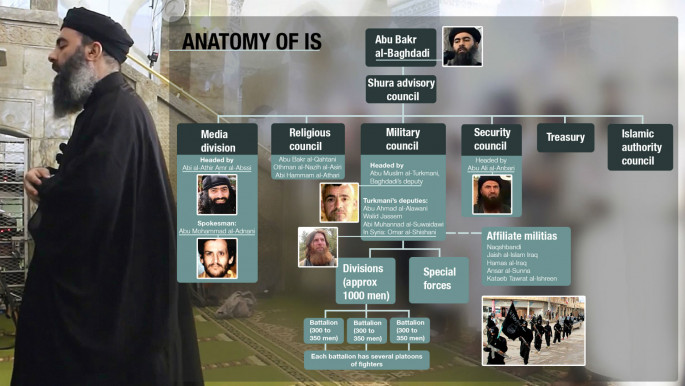Organising chaos: an anatomy of the IS group
Editor's note: This is the first of a two-part analysis. Read part two here.
Since its inception, the Islamic State group has demonstrated the firmness of its structure and the strength of its organisational composition.
The group developed strict bureaucratic institutions and connected political and military bodies at an early stage of its operation to create a centralised, expansionist organisation driven by a totalitarian religious ideology.
The group presents itself as the representative of a Sunni Islam that is under threat by the growth of Shia Islam, in addition being an anti-imperialist and anti-dictatorship organisation.
However, despite portraying itself as a Sunni Salafi movement that is attempting to reintroduce religion as the supreme force in society and state, and cleansing both society of "innovations" made to early Islam over the ages, the group is dependent on technological modernity and bases its military composition, bureaucratic systems and media apparatus on fascist organisational models.
The IS group chose a centralised organisational model early on, which caused disagreements in the global jihadi movement due to the fact that al-Qaeda, the most prominent jihadi group, had adopted a non-centralised model as theorised by the jihadi ideologue Abu Musab al-Suri in his book The Global Islamic Resistance Call.
RELATED: The rentier 'caliphate' with no new ideas. Analysis by Charles Tripp.
IS instead based its centralised model on the Management of Savagery, written by Abu Bakr Naji, another jihadi ideologue. In accordance with the Naji's theories, IS abandoned the old models of "jihadi solidarity" and "wars of spite" to weaken enemies, and adopted "wars of enablement" that would allow the group to establish a fixed geographical state.
The group also unified its intellectual reference points by relying on the Islamic legal writings of Abu Abdullah al-Muhajir and his book Questions from the Jurisprudence of Jihad, who prioritised fighting Arab and Muslim governments (the close enemy) and his belief that Shias were apostates. The IS also adopted his position on suicide bombings, the use of human shields, kidnap, beheadings and other violent tactics.
The IS group's centralised structure can be traced to Tawhid and Jihad, the group formed by Abu Musab al-Zarqawi in Iraq after the US invasion in 2003. His death on 6 June 2006 left his successors with a strong and cohesive organisation headed by Abu Omar al-Baghdadi, the nomme de guerre of Hamid Dawud al-Zawi, a former officer in the now dissolved Iraqi army.
The coming of the Islamic State group
 |
| Click here to enlarge |
On 15 October 2006, the group announced the formation of the Islamic State in Iraq (ISI), an organisation that was more centralised and bureaucratic. It presented its first "cabinet" through its spokesman Muharib al-Jubouri. Iraqi members dominated the group, with the only noticeable exception being the Egyptian Abu Hamza al-Muhajir, the group's "minister of war".
Baghdadi and Muhajir were killed on 19 April 2010, after which the group pledged allegiance to Abu Bakr al-Baghdadi, who became leader on 16 May 2010.
He developed the group's structure through solidifying the concept of "allegiance and obedience", strengthening its chain of command and ensuring his control over every aspect of organisational life.
He transformed the group into a secretive, security conscious military organisation, and gave himself sole authority over the declaration of war.
The position of minister of war was replaced by a "military council".
| Baghdadi transformed the organisation and gave himself sole authority over the declaration of war. |
Baghdadi appointed Iraqi members to key positions and used Arab and foreign members in supporting positions, such as the consultative council (shura), media, recruitment and fundraising.
He abolished ministries and replaced them with "state councils", the main pillars of the group which operate as a central command. Baghdadi however retained absolute power over their composition and membership.
On matters of war, Baghdadi used the military and intelligence experience of more than a thousand former Iraqi army officers who had joined his group.
The most prominent former Iraqi army officers in the ISI group were Haji Bakr, Abd al-Rahman al-Bilawi, Abu Muslim al-Turkmani and Abu Ali al-Anbari.
Through these and other highly experienced officers, the group's military council became very effective on both military and security fronts.
The group adopted the name "Islamic State" after the takeover of Mosul on 9 June 2014, and the subsequent announcement of the "caliphate" on 29 June 2014.
IS appointed Azhar al-Ubaidi as the governor of Mosul and Ahmed Abdul Rashid as the governor of Tikrit. Both were former brigadier generals in the Iraqi army.
It has now reached the point where the IS group has morphed from its Salafi-jihadi group beginnings to being an organised and complex military organisation that merges between traditionalism and modernism.
And just like any other totalitarian system, the IS group depends on a security apparatus to secure the areas under its control, a bureaucracy to administer its affairs, a military apparatus to protect its borders and widen its control and a media apparatus that promotes the group's ideology and manages its propaganda as an undefeatable organisation.
RELATED: Read the second part of Hassan Abu Haniyeh's exploration of the IS group.



